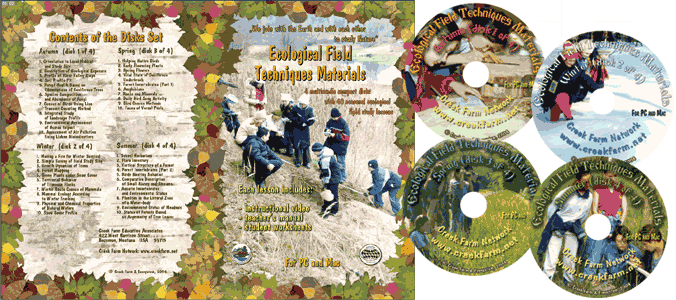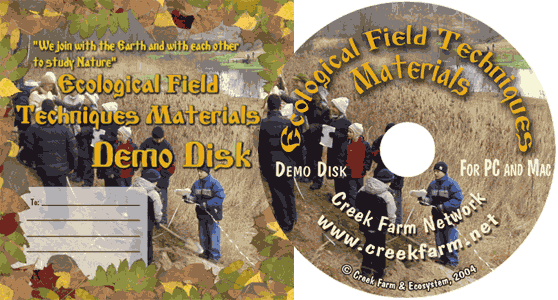|
| Our Field Ecology Center published more than
180 methodical materials for nature studies. Some of them are in English: |
|
|
|
Simple УEyeФ Survey of the Field Study Site
© Alexsander S. Bogolyubov,
Russia, 1999
© Michael J. Brody, USA,
2003
 This manual describes a procedure for creating a
simple "eye" survey of a field study site leading to a large-scale map of the
study area. It contains several different techniques of complex surveying including: field
sketching, a method of detour, polar method, a method of intersections and a method of
perpendiculars. This manual describes a procedure for creating a
simple "eye" survey of a field study site leading to a large-scale map of the
study area. It contains several different techniques of complex surveying including: field
sketching, a method of detour, polar method, a method of intersections and a method of
perpendiculars.
This field study has instructional video
featuring real students conducting the ecological field techniques in nature. Each video
illustrates the primary instructional outcomes and the major steps in accomplishing the
task including reporting the results.
Introduction
Conducting ecological field studies creates the need to plot observed objects,
phenomena and sites on a map. That, in turn, entails mastering skills of correct map-and
plan making and their proper usage.
The simplest methods of field site survey are usually applied in the course of
ecological studies; they do not require special equipment or precise instruments. Such
studies usually involve large-scale surveying, i.e. survey of small field sites
with high detail.
A draft, where a horizontal projection of a small site is taken as being flat and
plotted in a reduced and similar form is called a plan.
A draft, where a large site or the whole area is plotted taking into consideration its general
contour or relief, is called a map.
A survey that allows a person to make a plan or a map without taking into account
relief and crookedness of the surface is called plane survey.
A survey that allows the study of heights of certain sites is called vertical
surveying or leveling.
Students will master the simplest skills of plane surveying with the help of only a
compass and by counting steps at the given practical part of the lesson. They will not
require any other equipment or instruments except a tape measure and a stable flat
surface.
Introductory part of the lesson
The lesson should begin with some instruction: students should review concepts of a
plan, a map, scale and conventions, which have been learned earlier in the lesson devoted
to orienteering (Lesson #1, fall).
The introductory or theoretical part of the lesson should contain an explanation of techniques
for eye surveying an area Ц making a field sketch, a method of detour, a polar method,
method of intersections and a method of perpendiculars. The subsequent fieldwork will
likely include all or some the above-mentioned techniques depending on the structure of
the area and objects for surveying. Each of the techniques is described below in
corresponding chapters.
Students should again master the practical skills of angles (azimuths)
measurement (reminder: an azimuth is an angle between the direction to the North and the
direction to the desired object, which is measured clockwise) as well as skills of
distance measurement by counting steps (see Lesson #1, fall).
Structure of the field studies
Objectives of the present practical lesson include making a plan of the site in
the immediate vicinity of the school or ecological field study center, onto which the main
landmarks are plotted: forest tracks, water-bodies, roads, paths, forest cuttings,
buildings, power transmission lines, etc. The size of the site for surveying depends on
the number of students who accomplish the task and the structure of the site, i.e. the
УsimplicityФ of the given area.
Students usually work in groups of 10-12 people in the Ecological Field Study
Center УEcosystem," which is located in a forest massif. They make a survey of part
of a forest site that measures 500 m x 500 m. At the same time, a group of the same number
of students conducts a survey of another site, located in the river floodplain, with a
size of only 50 m x 100 m. It is obvious that the time spent on surveying depends on the
number of details that have to be plotted on a map. There are only two glades, one path
and four forest cuttings along the perimeter of the forest site, whereas a small site in
the floodplain contains a meandering shoreline, a stream, several paths, a lake, a slope
of the terrace located above the floodplain, etc. In other words, the teacher determines
the size of the site for surveying according to the complexity of the task.
The number of students who work together also depends on the structure of the site.
When surveying a complex site, for example, a river floodplain, it is optimal to divide
the group into teams of 3-4 students. Each team should be given a certain site for
surveying so that the surveyed sites can be combined into one general plan of the area at
the closing part of the lesson.
When surveying a simple but vast site, for instance, a rectangular forest massif, it is
advised to divide the group into smaller teams of two students and each of them is ...
This was only the first page from the manual and its full version you can see in the
Ecological Field Studies Techniques Video 4CD Set:
It is possible to purchase the complete set of 40 seasonal Ecological Field
Studies Techniques Video (in mpg format) in an attractive 4 compact disk set.
These compact disks are compatible with Mac and PC computers.
The videos are suitable for individual student or whole class instruction. To purchase the complete 4CD set
write to ecosystema1994@yandex.ru in a free form.

Ecological Field Studies Demo Disk:
We also have a free and interesting demonstration disk that explains our ecological field studies approach.
The demo disk has short excerpts from all the seasonal field study videos as well as sample text from all the teacher manuals.
The disk has an entertaining automatic walk through which describes the field study approach and explains how field studies meet education standards.
You can also download the Demo Disc from ecosystema.ru/eng/eftm/CD_Demo.iso.
This is a virtual hybrid (for PC and Mac computers) CD-ROM image (one 563 Mb file "CD_Demo.iso").
You can write this image to the CD and use it in your computer in ordinary way.
You also can use emulator software of virtual CD-ROM drive to play the disk directly from your hard disk.

|







